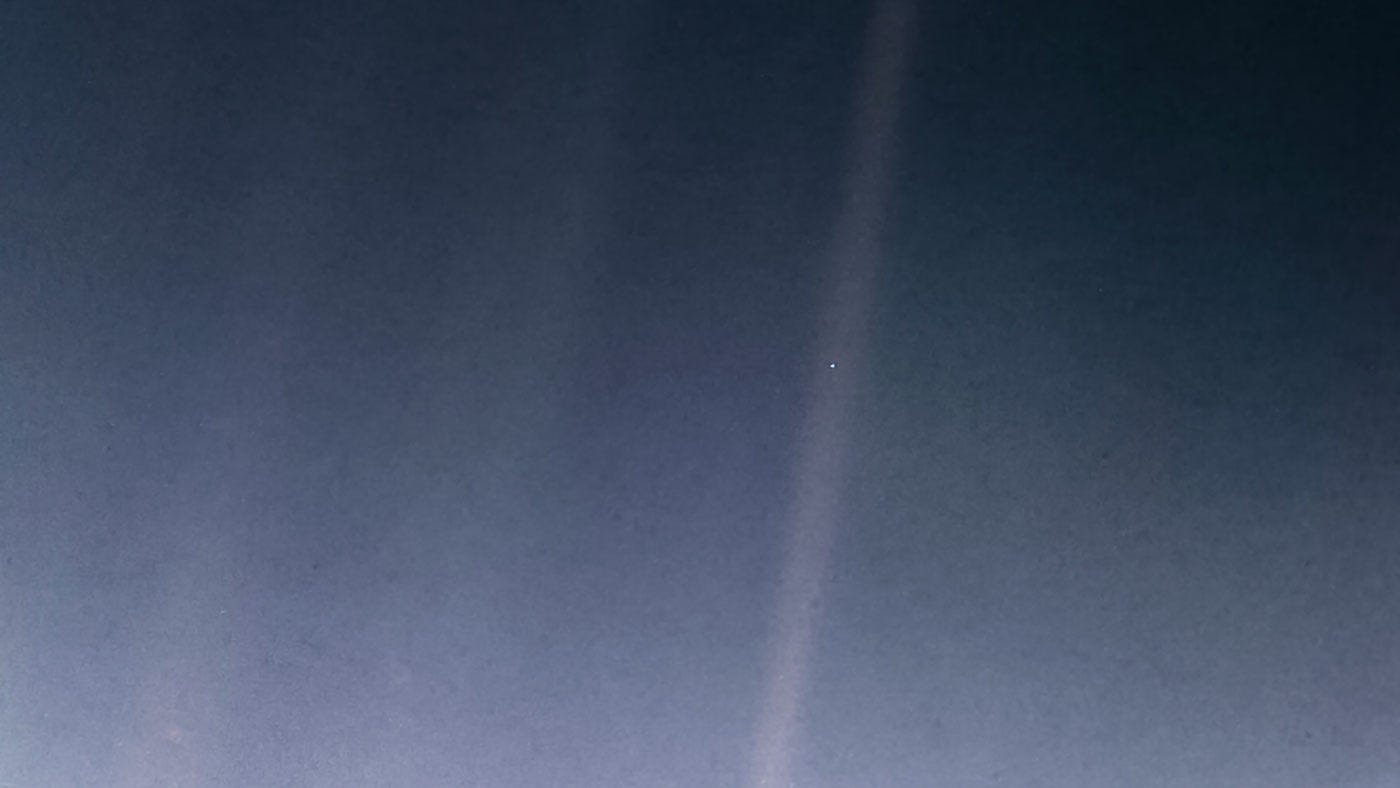NASA/JPL-Caltech
One of the hardest concepts for any geology student to really understand is time. On many occasions, I’d be standing on a dark weathered rock outcrop, probably in the rain, listening to a wizened, grey haired, bearded lecturer who at some point would inform us that the black amorphous mass beneath us was 60 million years old. Comparatively young for Scotland. Some of the oldest rocks in the world are north of the border and are up to 3,000 million years old. Long before dinosaurs, long before anything really.
Space, the final frontier
An equally vast concept is space. The tiny dot in the picture above is earth. It was taken by NASA’s Voyager 1 spacecraft in 1990, when it was leaving our solar system. It was already beyond Neptune, 6 billion kilometres from the sun.
The idea for taking the photograph was the brainchild of Carl Sagan. I’ve mentioned him before. He was an advocate who promoted the Search for Extra-Terrestrial Intelligence, SETI. He’s the author of many books including Pale Blue Dot.
As a member of the Voyager Imaging Team, he pondered the question, why not take a picture looking back at earth? He knew the distances involved meant any images acquired were likely to be unremarkable. Precisely why Sagan and other members of the Voyager team kept asking for a shot to be taken. Let humanity see what a tiny spec of nothingness earth represents in the vast ocean of space.
It’s so incredibly special
Eventually, they secured extra funding for the additional resources needed and on 13th February, 1990, Voyager 1’s cameras were warmed up for 3 hours before the family photos were taken of the planets in our solar system. For various reasons Mars, Mercury and Pluto couldn’t be seen. But caught in scattered light rays because of the closeness of the sun, is earth, a tiny point, a crescent, 0.12 pixels in size.
34 minutes later, Voyager 1’s cameras were powered off forever, to save power for the long journey ahead. By August 2012, it entered interstellar space, 12,161,300,000 miles from Earth and now the most distant human object.
Space X - Starship
Elon Musk would have us believe that there will be a self-sustaining city on Mars by 2050.
The first step to infinity and beyond is to offer you and me super fast city trips like London to New York in 30 minutes. In British Airways old parlance this is probably a couple of leaps above Concorde Class, which was more expensive than First. Aside from all the boring details of where a rocket would take off from in London, it would then fly above earth’s atmosphere, before landing a little later in New York.
Starship, Musk’s biggest rocket will be able to carry 100 passengers in crew mode. A prototype was successfully demonstrated launching and landing during the recent pandemic and a version of the Starship is now expected to travel to the moon and finally to Mars. This desire is based on Musk’s concern that humans are doomed on earth and will be forced to leave at some point in the future. That’s going to be some golden ticket, if the only option for survival is to leave the planet. But then why bother charging for it and only consider the rich? Use another means of selection because the traditional sense of payment is meaningless on a dead planet.
Dangerous delusion
The idea of space travel fires many an imagination and Musk should be encouraged to pursue his dreams. In comparison to developing nuclear warheads or lasers that knockout other government’s satellites who we don’t agree with, this is a far more beneficial and productive way to spend time and money.
Britain’s chief astrophysicist Lord Martin Rees, is a little more grounding and says Musk’s plans to send humans to Mars are a "dangerous delusion”. “Living on Mars is no better than living on the South Pole or the tip of Mount Everest," he added.
Also speaking at the same recent conference, was American astrophysicist and science educator Neil deGrasse Tyson, who rather boringly pointed out that making Mars habitable (a process called terraforming) was a significantly larger problem than preventing the catastrophe on earth in the first place; “it is so much easier to make Earth return to Earth again.”
Sagan’s point
The picture captures succinctly what every government needs to remember and act upon. The earth is the only known place in the universe to support life. There is nowhere else to migrate to in the near future. This is it. This is all we’ve got. It’s a miracle that we’re here in the first place. With that in mind, think about today’s news - the current spat with the EU caused by our decision to leave, or this government’s decision to cut international aid to serve what purpose? We can do better. We have to do better.
Extract from Sagan’s, Pale Blue Dot
Look again at that dot. That's here. That's home. That's us. On it everyone you love, everyone you know, everyone you ever heard of, every human being who ever was, lived out their lives. The aggregate of our joy and suffering, thousands of confident religions, ideologies, and economic doctrines, every hunter and forager, every hero and coward, every creator and destroyer of civilisation, every king and peasant, every young couple in love, every mother and father, hopeful child, inventor and explorer, every teacher of morals, every corrupt politician, every "superstar," every "supreme leader," every saint and sinner in the history of our species lived there--on a mote of dust suspended in a sunbeam.



